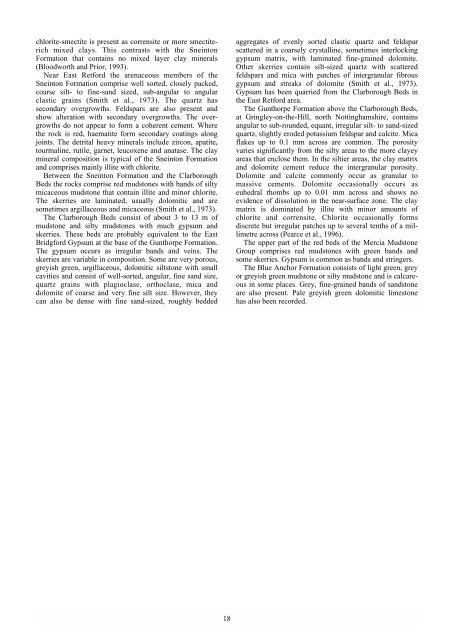Engineering geology of British rocks and soils Mudstones of the ...
Engineering geology of British rocks and soils Mudstones of the ...
Engineering geology of British rocks and soils Mudstones of the ...
You also want an ePaper? Increase the reach of your titles
YUMPU automatically turns print PDFs into web optimized ePapers that Google loves.
chlorite-smectite is present as corrensite or more smectiterich<br />
mixed clays. This contrasts with <strong>the</strong> Sneinton<br />
Formation that contains no mixed layer clay minerals<br />
(Bloodworth <strong>and</strong> Prior, 1993).<br />
Near East Retford <strong>the</strong> arenaceous members <strong>of</strong> <strong>the</strong><br />
Sneinton Formation comprise well sorted, closely packed,<br />
coarse silt- to fine-s<strong>and</strong> sized, sub-angular to angular<br />
clastic grains (Smith et al., 1973). The quartz has<br />
secondary overgrowths. Feldspars are also present <strong>and</strong><br />
show alteration with secondary overgrowths. The overgrowths<br />
do not appear to form a coherent cement. Where<br />
<strong>the</strong> rock is red, haematite form secondary coatings along<br />
joints. The detrital heavy minerals include zircon, apatite,<br />
tourmaline, rutile, garnet, leucoxene <strong>and</strong> anatase. The clay<br />
mineral composition is typical <strong>of</strong> <strong>the</strong> Sneinton Formation<br />
<strong>and</strong> comprises mainly illite with chlorite.<br />
Between <strong>the</strong> Sneinton Formation <strong>and</strong> <strong>the</strong> Clarborough<br />
Beds <strong>the</strong> <strong>rocks</strong> comprise red mudstones with b<strong>and</strong>s <strong>of</strong> silty<br />
micaceous mudstone that contain illite <strong>and</strong> minor chlorite.<br />
The skerries are laminated, usually dolomitic <strong>and</strong> are<br />
sometimes argillaceous <strong>and</strong> micaceous (Smith et al., 1973).<br />
The Clarborough Beds consist <strong>of</strong> about 3 to 13 m <strong>of</strong><br />
mudstone <strong>and</strong> silty mudstones with much gypsum <strong>and</strong><br />
skerries. These beds are probably equivalent to <strong>the</strong> East<br />
Bridgford Gypsum at <strong>the</strong> base <strong>of</strong> <strong>the</strong> Gunthorpe Formation.<br />
The gypsum occurs as irregular b<strong>and</strong>s <strong>and</strong> veins. The<br />
skerries are variable in composition. Some are very porous,<br />
greyish green, argillaceous, dolomitic siltstone with small<br />
cavities <strong>and</strong> consist <strong>of</strong> well-sorted, angular, fine s<strong>and</strong> size,<br />
quartz grains with plagioclase, orthoclase, mica <strong>and</strong><br />
dolomite <strong>of</strong> coarse <strong>and</strong> very fine silt size. However, <strong>the</strong>y<br />
can also be dense with fine s<strong>and</strong>-sized, roughly bedded<br />
18<br />
aggregates <strong>of</strong> evenly sorted clastic quartz <strong>and</strong> feldspar<br />
scattered in a coarsely crystalline, sometimes interlocking<br />
gypsum matrix, with laminated fine-grained dolomite.<br />
O<strong>the</strong>r skerries contain silt-sized quartz with scattered<br />
feldspars <strong>and</strong> mica with patches <strong>of</strong> intergranular fibrous<br />
gypsum <strong>and</strong> streaks <strong>of</strong> dolomite (Smith et al., 1973).<br />
Gypsum has been quarried from <strong>the</strong> Clarborough Beds in<br />
<strong>the</strong> East Retford area.<br />
The Gunthorpe Formation above <strong>the</strong> Clarborough Beds,<br />
at Gringley-on-<strong>the</strong>-Hill, north Nottinghamshire, contains<br />
angular to sub-rounded, equant, irregular silt- to s<strong>and</strong>-sized<br />
quartz, slightly eroded potassium feldspar <strong>and</strong> calcite. Mica<br />
flakes up to 0.1 mm across are common. The porosity<br />
varies significantly from <strong>the</strong> silty areas to <strong>the</strong> more clayey<br />
areas that enclose <strong>the</strong>m. In <strong>the</strong> siltier areas, <strong>the</strong> clay matrix<br />
<strong>and</strong> dolomite cement reduce <strong>the</strong> intergranular porosity.<br />
Dolomite <strong>and</strong> calcite commonly occur as granular to<br />
massive cements. Dolomite occasionally occurs as<br />
euhedral rhombs up to 0.01 mm across <strong>and</strong> shows no<br />
evidence <strong>of</strong> dissolution in <strong>the</strong> near-surface zone. The clay<br />
matrix is dominated by illite with minor amounts <strong>of</strong><br />
chlorite <strong>and</strong> corrensite. Chlorite occasionally forms<br />
discrete but irregular patches up to several tenths <strong>of</strong> a millimetre<br />
across (Pearce et al., 1996).<br />
The upper part <strong>of</strong> <strong>the</strong> red beds <strong>of</strong> <strong>the</strong> Mercia Mudstone<br />
Group comprises red mudstones with green b<strong>and</strong>s <strong>and</strong><br />
some skerries. Gypsum is common as b<strong>and</strong>s <strong>and</strong> stringers.<br />
The Blue Anchor Formation consists <strong>of</strong> light green, grey<br />
or greyish green mudstone or silty mudstone <strong>and</strong> is calcareous<br />
in some places. Grey, fine-grained b<strong>and</strong>s <strong>of</strong> s<strong>and</strong>stone<br />
are also present. Pale greyish green dolomitic limestone<br />
has also been recorded.

















